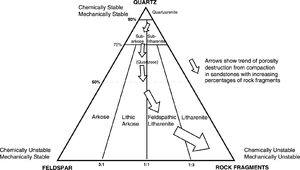Sandstone diagenesis: composition and texture
| Exploring for Oil and Gas Traps | |

| |
| Series | Treatise in Petroleum Geology |
|---|---|
| Part | Predicting the occurrence of oil and gas traps |
| Chapter | Predicting reservoir system quality and performance |
| Author | Dan J. Hartmann, Edward A. Beaumont |
| Link | Web page |
| Store | AAPG Store |
Composition and diagenesis
Composition affects sandstone diagenesis in two ways:
- The higher the quartz content, the greater the mechanical stability (less compaction occurs).
- The higher the variety of minerals, the lower the chemical stability (more cementation or dissolution occurs).
Sandstones with abundant lithics, feldspars, or chert have less occlusion of porosity by quartz overgrowths and more secondary porosity through dissolution of less stable grains. The ratio of quartz to ductile grains is key to compaction porosity loss.
Sediment composition and provenance

Provenance determines sand grain mineralogy and sediment maturity. Mechanical and chemical weathering affects sand grains during transportation. The final product reflects the origin, amount of reworking, and transport distance.
For example, sandstones derived from subduction trench margins are generally mineralogically immature. They often contain terrigenous detritus with abundant volcaniclastics and pelagic material. Sandstones derived from the margin of a cratonic basin tend to be mineralogically and texturally mature and contain reworked sedimentary detritus.
Figure 1 summarizes the effects of sediment composition on mechanical stability and chemical stability.
Influence of grain size on porosity and diagenesis
Sorting and grain size are textural parameters that intuitively might seem to have the same effects on the porosity of a reservoir system sandstone. Studies show, however, that porosity is largely independent of grain size for unconsolidated sand of the same sorting.[2] Size does affect permeability; the finer the sand, the lower the permeability. Permeability indirectly affects porosity through diagenesis. Stonecipher et al.[3] suggest that slow fluid fluxes, resulting from low permeability, promote cementation; rapid fluxes promote leaching. In rapid fluxes, solutes do not remain in pore spaces long enough to build local concentration that promotes precipitation of cement. In slow fluxes, they do. Also, size affects the surface area available for diagenetic reactions: the finer the grain size, the greater the grain surface area for a volume of sediment or rock.
Influence of sorting on porosity
Sorting and porosity strongly correlate in unconsolidated sandstones.[2] The better the sorting, the higher the porosity. The initial porosities of wet, unconsolidated sands show a range of 44–28% porosity for well-sorted vs. poorly sorted grains. Well-sorted sands tend to have a higher percentage of quartz than do poorly sorted sands, and they tend to maintain higher porosities during burial than poorly sorted sands. Poorly sorted sands have more clay matrix and nonquartz grains.
See also
- Sandstone porosity and permeability prediction
- Sandstone diagenetic processes
- Hydrology and sandstone diagenesis
- Influence of depositional environment on sandstone diagenesis
- Predicting sandstone reservoir porosity
- Predicting sandstone permeability from texture
- Estimating sandstone permeability from cuttings
References
- ↑ Loucks, R. G., M. M. Dodge, and W. E. Galloway, 1984, Regional controls on diagenesis and reservoir quality in Lower Tertiary sandstones along the Texas Gulf Coast, in D. A. McDonald and R. C. Surdam, eds., Clastic Diagenesis: AAPG Memoir 37, p. 15–45.
- ↑ 2.0 2.1 Beard, D., C., Weyl, P., K., 1973, Influence of texture on porosity and permeability of unconsolidated sand: AAPG Bulletin, vol. 57, no. 2, p. 349–369.
- ↑ Stonecipher, S., A., Winn, R., D. Jr., Bishop, M., G., 1984, Diagenesis of the Frontier Formation, Moxa Arch: a function of sandstone geometry, texture and composition, and fluid flux, in McDonald, D., A., Surdam, R., C., eds., Clastic Diagenesis: AAPG Memoir 37, p. 289–316.